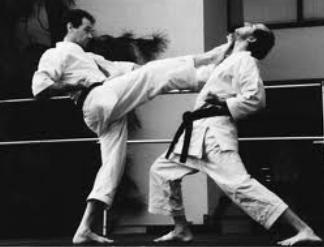
The Front Kick, the Japanese call it Mae-Gari. There are several variations of the front kick and all can be completed using either the lead leg or rear leg depending on the purpose of the kick when it’s being executed. Today we’re going to talk about the basics of the rear leg front kick and how it’s delivered into the target.
The front kick is probably the most used kicks in Martial Arts. The rear leg front kick begins from the fighters base stance, depending on the style of Martial Art being studied this stance can vary greatly from something as narrow as 50/50 stance to even a 70/30 stance depending on training and execution of the kick.
Let first take a look at the three most common used rear leg front kicks. Rear Leg Snap Kick – Rear Leg Thrust Kick with the ball of the foot – Rear Leg Thrust kick with heal of the foot.
The Snap Kick from a rear leg can be a very devastating kick, usually the target area with the Snap Kick is the groin or inner femoral nerve. Concern in using the Snap Kick is the potential of hyper extending the ankle joint when the top of the strikers foot comes into contact with the target, not to mention the number of small bones found in the top of the foot which could be exposed to possible fractures and breaks.
The Rear Leg Thrust kick with the ball of the foot is used to impact the target with the ball of the foot. This type of kick can be one of the farthest reaching strikes that one has available to them. The target area is struck with ball of the foot, the toes are curled back from the target for protection and the kick is followed through with the ball of the foot. Most common target area for this kick would be the mid section, chest and face. Personal concerns are the accidental impact of the toes or toe on your intended target causing more damage to you that your attacker.
The Rear Leg Thrust kick with the heal of the foot is a very powerful and very damaging kick. Target areas for this kick can be front of the knee, hips, pelvis, stomach and chest. There’s no disputing the self-defense potential of the front kick. Used as an explosive, committed attack or counterattack, a deep front kick into an assailant’s stomach will probably end many conflicts outright.
Unlike many kicks, the front kick doesn’t lose power and effectiveness at close range. Even if an attacker lunges when the kick is executed it will still leave him jarred and when the follow through is finished most time your attacker will find themselves on the ground. From a defensive standpoint, the front kick is a very safe kick to execute for the practitioner, even if the leg is grabbed, the kicker will no be upended as easy with more complicated or flashy kicks.
So just how does the body produce the kind of energy from a rear leg kick to send a man to the ground? The front kick is executed by lifting the knee of the rear leg above your waist line, body dynamics will now cause the foot that’s on the ground to turn to approximate 30 to 50 degrees depending on how high the knee is raised and the hip will begin turning slightly into the direction of the target. It’s interesting to note that to this point you’ve used hips and abs to lift the knee and leg into it’s current position and now your ready to complete the strike. At this point the striker engages quad muscles, hamstring, abs and hip muscles to extend the leg out in front of them and pushes it forward into the target with the hip being used to follow through into the attacker, thus created a longer time on target causing the heal of the foot to compress farther into the attackers body.
The Rear Leg Front Kick.
Sensei Rob Andress, Ancho Jujitsu
Jiu Jitsu in Brockville – Martail Arts Brockville – Self Defence in Brockville
